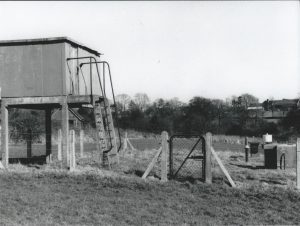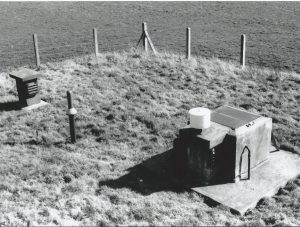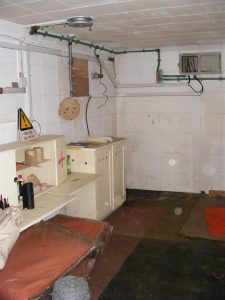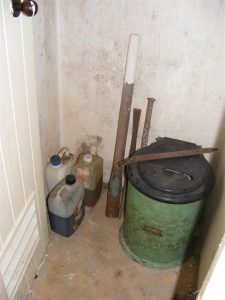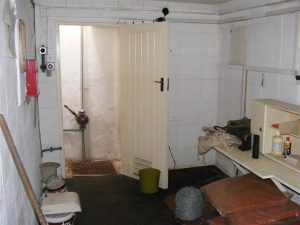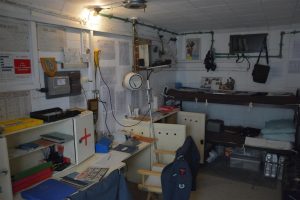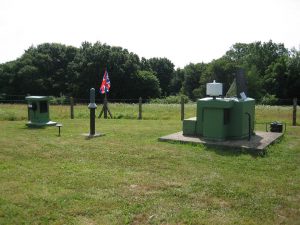Cuckfield Royal Observer Corps/Nuclear Bunker
Cuckfield ROC Post History
Cuckfield ROC post was opened in June 1962 and was and was originally closed in 1968 as part of the budget cut backs during that year. However due to flooding and water ingress at the nearby Ditchling post, Cuckfield was re-opened in 1970 to replace Ditchling which was subsequently closed.
Cuckfield then remained in continual service as a Master ROC post in a cluster with Brighton and Lewes Posts until stand down in 1991 when it was closed when the Corp disbanded. The post then remained unlocked and abandoned until the post was visited by mark Russell in 2007. The condition of the post was found to be exceptional, it was dry, in an intact compound and with the majority of the main fabric of the post extant and in good order. After numerous meetings with the local Cuckfield Parish Council Mark gained permission to care take and restore the post to enable it to be opened for the public to visit.
Restoration started in earnest in the winter of 2009; initially with Mark on his own but in the beginning of 2010 he was joined by Ed Combes who came on board to assist. Despite the post being dry and in good order a lot of work was still needed as 20 years of the elements had taken its toll. This included getting rid of rotten wood, painting the furniture, shaft, ladder, surface structures, gate, floor. You name it, it needed painting! After this, the next step was sourcing some of the missing equipment. This included the bunk bed, the chairs and various other bits and pieces. The majority of the ROC ‘equipment’ Mark and Ed already had in their personal collections as they had been collecting for exactly this eventuality, various other pieces were sourced from other ROC post restorers, and the museum now has a complete complement of original ww2 era and cold war equipment, paperwork and items.
By 2010, the restoration work had been completed and the post was ready for its first visitors. The post is open 5 or 6 days throughout the summer months, and regularly gets an average of 40-50 visitors a day. In particularly fine weather the number per day has been as high as 100 people. The open days are well supported by the Parish Council (who own the land) and the Cuckfield Museum (who generously organise group bookings for visits to the post).
The plan for the post is to keep running open days and weekends until interest dwindles and then keep it maintained and open it for interested persons and groups on a more ad hoc basis.
The Royal Observer Corp General history
The Royal Observer Corps (ROC) was first introduced in 1925 following the famous ‘Zeppelin Raids’ of the First World War and to help to identify incoming enemy aircraft. Originally the Corp was known as ‘The Observer Corp’ but was granted the Royal title after their services during the Second World War.
In the 1950′s the threat of nuclear attack from Soviet Russia rapidly increased with the escalation of the Cold War and the super weapons races. This necessitated the monitoring of a nuclear burst and the subsequent fall-out in order to provide warning and support to the civilian population. This responsibility fell to the ROC and 1563 underground monitoring posts were constructed around the British Isles.
In 1955 the government announced that steps were being taken for the ROC to give warning, and measure the effect, of a nuclear attack in event of a future war with the Soviets – this new duty was originally only secondary to the identification of incoming hostile aircraft. The Royal Observer Corps was chosen as they already possessed the infrastructure and personnel to fulfil this role, and just needed training on extra monitoring equipment.
The posts where grouped in clusters of 3-4 with a main master post in each cluster. The master post had a VHF radio as well as the land-line based loud speaker telephone which ensured that communication was possible from all posts to the group HQ’s. The regional headquarters were staffed by plotters and scientific officers who would predict the areas that were to be affected by nuclear fallout. This enabled the authorities to decide which services could remain in operation, and where to direct precious resources.
To give protection from the fall-out of a nuclear attack these monitoring rooms were constructed 15ft underground, usually at the location of a pre-existing WW2 Orlit post. The underground room measured 15ft by 7ft and was manned by 2-3 staff on a two week rotation. The posts were not manned 24/7 but rather there was an expectation that there would be a ‘transition to war’ phase marked by increased border and political hostilities – it would be at this point the posts would be manned. This was referred to as ‘Manning up the post’. During ‘peacetime’ the post crew would meet weekly for training and to conduct maintenance and operational equipment test. It was very much a social organisation, with big emphasis placed on summer camps, friendships and social activities. It’s worth noting that the vast majority of the staff were unpaid volunteers with only senior staff and scientific officers at group HQ’s being salaried staff. Volunteers were able to claim expenses for travel and posts were issued ‘petty cash’ for maintenance etc.
As of 1992 all of the remaining The Royal Observer Corp were stood down and the ROC posts were decommissioned and returned to the public sector, with many being brought up by telecoms companies due to their elevated positions. Unfortunately a great number were left derelict and have now been demolished, flooded or vandalised. However, a number of posts up and down the country have been restored, either as private endeavours or as a joint venture among like-minded individuals.
Key Dates in the History of The Royal Observer Corp
1925 – The Observer Corp is formed
January 1929 – The Air Ministry takes control of the Corps, an Air Commodore is appointed as Commandant and the motto ‘Forewarned is Forearmed’ is adopted
24th August 1939 – The Corps is mobilised at the start of the Second World War
July – October 1940 – Battle of Britain
9th April 1941 – King George VI grants the title ‘Royal’ for services during the ‘Battle of Britain’
September 1941 – Women are admitted to the Corps
June 1944 – The Seaborne Venture, in support of D-Day
May 1945 – Stand Down, end of Second World War
January 1947 – Corps re-forms
11th April 1950 – King George VI becomes the first Air Commodore-in-Chief and the Royal Observer Corps medal is instituted
2nd June 1953 – Queen Elizabeth II assumes the appointment if Air Commodore-in-Chief
1955 – The nuclear reporting role is introduced
24th June 1956 – Review of the Corps by HM Queen Elizabeth II, Presentation of the Royal Observer Corps banner.
1968 -Re-organisation, reduction in establishment and closure of some posts
1971 – Data transmission introduced and a close association formed with the Danish Home Guard
1975 – Golden Jubilee of the Corps
1981-5 – Installation of new, modern, communications networks begins
27th June 1985 – Golden Anniversary Garden party
25th July 1991 – Review of the Corps by HM Queen Elizabeth II accompanied by HRH the Duke of Edinburgh
30th September 1991 – Stand down of the Corp
Article written by Edward Coombes
